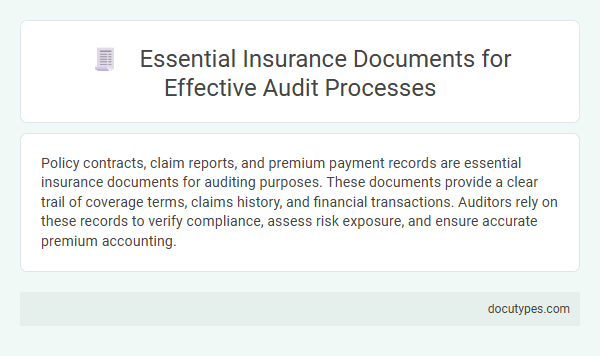Policy contracts, claim reports, and premium payment records are essential insurance documents for auditing purposes. These documents provide a clear trail of coverage terms, claims history, and financial transactions. Auditors rely on these records to verify compliance, assess risk exposure, and ensure accurate premium accounting.
Overview of Essential Insurance Documents
| Insurance Document | Description | Purpose in Auditing |
|---|---|---|
| Policy Declaration Page | Summarizes key details including policyholder information, coverage types, limits, and effective dates. | Verifies coverage terms and ensures policy alignment with audit criteria. |
| Insurance Policy Document | Contains the full contractual terms, conditions, endorsements, and exclusions of the insurance coverage. | Assesses compliance with regulatory requirements and contract accuracy. |
| Premium Payment Receipts | Proof of payment history for insurance premiums including dates and amounts. | Confirms active policy status and verifies financial transactions. |
| Claim Records and Reports | Documentation of claims submitted, processed, and their resolutions including amounts paid. | Evaluates claim management practices and financial liabilities. |
| Loss Runs | Detailed report of historical claims data showing frequency, severity, and trends. | Analyzes risk exposure and assists in underwriting assessments. |
| Certificate of Insurance | Official document proving existence of insurance coverage to third parties. | Verifies coverage compliance required by contracts or regulations. |
| Reinsurance Agreements | Contracts outlining terms of risk transfer between primary insurer and reinsurer. | Examines risk distribution and financial stability aspects. |
Importance of Proper Documentation in Audits
Which insurance documents are essential for auditing purposes? Proper documentation ensures transparency and accuracy during audits. Maintaining comprehensive records helps verify policy details and claims, facilitating effective risk management.
Key Policy Documents Required for Insurance Audits
Insurance audits demand thorough documentation to verify policy compliance and risk management. Key policy documents enable auditors to assess coverage details and financial accuracy effectively.
- Insurance Policy Document - This serves as the primary contract outlining coverage terms, conditions, and exclusions between the insurer and the insured.
- Claims History Report - Provides detailed records of filed claims, helping auditors evaluate claims patterns and verify payment accuracy.
- Premium Payment Records - Documentation of premium payments confirms that policies remain active and financial transactions are properly recorded.
Claims Records and Supporting Evidence
Claims records are critical insurance documents that provide detailed information about each submitted claim, including dates, amounts, and outcomes. Supporting evidence, such as medical reports, repair bills, and police reports, substantiates the validity of claims and ensures accuracy during audits. You must maintain organized and complete claims documentation to facilitate a smooth auditing process and verify compliance with policy requirements.
Premium Payment Receipts and Schedules
Premium payment receipts and schedules play a crucial role in insurance auditing by providing clear evidence of financial transactions. These documents ensure that all premium payments are accurately recorded and align with the policy terms. You should keep these records organized to facilitate smooth and transparent audits.
Compliance Certificates and Regulatory Filings
Compliance certificates and regulatory filings are essential insurance documents for auditing purposes. These documents verify adherence to industry standards and legal requirements, ensuring transparency and accountability.
Compliance certificates confirm that your insurance operations meet mandated regulations, reducing the risk of penalties during audits. Regulatory filings provide detailed records submitted to governing bodies, reflecting that all necessary disclosures and financial statements are accurately reported. Maintaining these documents in an organized manner facilitates smoother audit processes and supports regulatory compliance.
Endorsements, Riders, and Amendments Documentation
Endorsements, riders, and amendments are crucial insurance documents that modify the original policy terms. These documents provide detailed records of changes made after the policy issuance, ensuring accuracy during audits.
Maintaining thorough documentation of endorsements and riders helps verify coverage adjustments and premium modifications. Auditors rely on these records to confirm compliance with contractual obligations and regulatory standards.
Renewal Notices and Expiration Dates
Renewal notices and expiration dates are critical insurance documents for auditing purposes. These documents ensure coverage continuity and verify policy validity within the audit period.
- Renewal Notices - Confirm upcoming policy renewals and any changes in coverage or premiums.
- Expiration Dates - Establish the exact end date of the insurance policy to assess risk gaps and compliance.
- Audit Compliance - Facilitates verification that insurance coverage aligns with regulatory and contractual requirements during the audit.
Loss Run Reports and Historical Claims Data
Loss Run Reports are critical insurance documents that detail the history of claims made on a policy. These reports provide auditors with a comprehensive view of the frequency, severity, and patterns of losses over a specified period.
Historical Claims Data offers valuable insights into past incidents and helps assess the risk profile of an insured entity. Auditors rely on this data to verify the accuracy of reported claims and ensure compliance with underwriting guidelines.
Which Insurance Documents Are Essential for Auditing Purposes? Infographic

